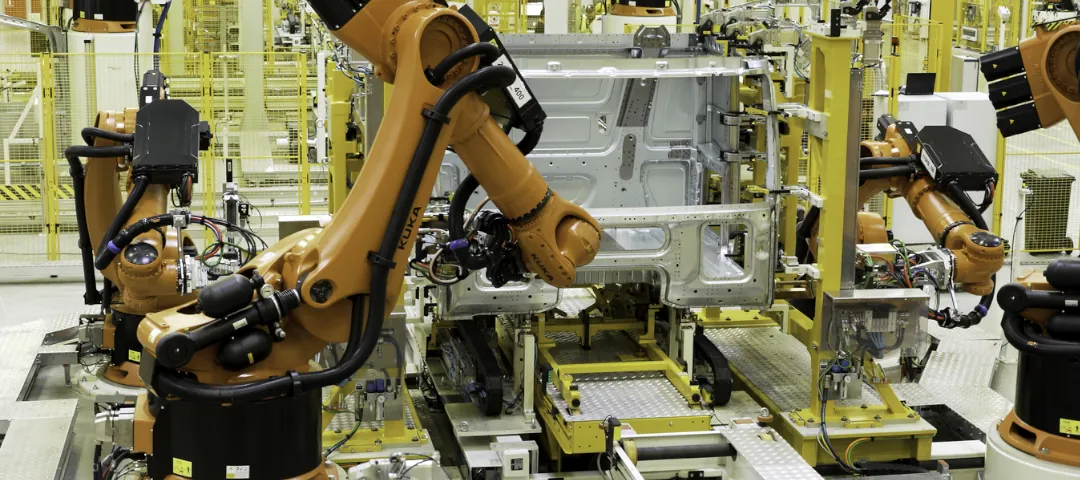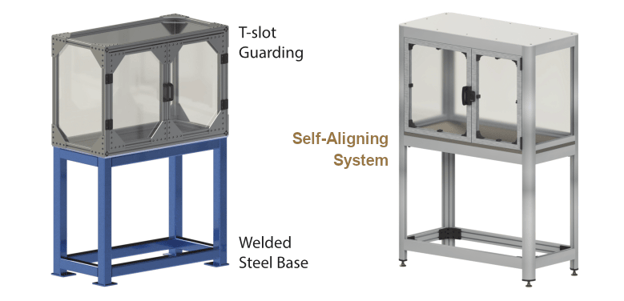5 Robotics Safety Rules for Industrial Enclosure Design

Enclosures: dumb, boring, and a savior for automation.
Industrial modular machine enclosures don’t plug in, and there’s no software – which is why smart design is critical for your team’s safety and efficiency.
Specific to the framing in the base and guarding, there are several robotics safety rules you should follow. These guidelines will not only help you make safety features that are actually safe; they’ll also save a ton of money. (In one case, we’re talking paying $1,000 vs. $35,000.)
Robotics Safety Rules: From Stability to Strength
Industrial automation safety means starting at the foundational basics. An enclosure’s base and guarding should account for:
- Cyclic loading
- Access
- Size
- Integration & flexibility
- Safety
Rule #1: Cyclic Loading
Imagine you’ve bought and assembled a new Ikea bookshelf, but your partner changes their mind almost daily about the room’s feng shui. If you frequently move the unit back and forth across the room, it’s going to fall apart quickly.
On the production line, you want robotics that can rotate safely and reliably … which is why traditional T-slot extruded framing isn’t the best choice. These static applications involve frequent cyclic loading. Ideally your assembly will stay put during that repetitive stress, but that’s rarely the case, as these examples show:
- A robotic arm mounted to traditional T-slots will loosen with vibration, which may in turn misalign the machine’s safety guarding.
- A lot of conveyor systems use T-slots for the entire assembly, and thus require frequent retightening and realignment.
While the material itself is actually deceptively strong, its connections don’t hold in dynamic situations, leading to a short service life. For those in the “T-slots for everything!” club, industrial enclosure solutions tend to go one of three ways:
- Use the status quo, watch the assembly falter, then go back and drill and add brackets
- Overdesign to make sure it doesn’t slowly fall apart
- Keep a full-time welder on staff to patrol machine stations and weld any weakening T-slot connections
If you want the benefits of aluminum in a robot enclosure, you’re not out of luck – you just need an advanced extrusion frame. Self-aligning aluminum systems are an evolution of sorts for T-slots in that they’re modular and lightweight, but also sturdy and reliable. Thanks to advanced engineering of fasteners and brackets, these enclosure frames are manufactured to stay precisely aligned – even with repetitive motion or vibration.
Rule #2: Access
Overdesign and under-engineering are running themes with automated machinery enclosures.
T-slot enclosures feature heavy cross-bracing and bolting to make the structure more rigid. An excess of components makes human intervention inconvenient and unsafe when you want to make changes to equipment or access the enclosure’s door.
Look at a standard robot pedestal – a simple 1x1x3 frame bolted to the ground, with protective fencing. Almost every commonly available kit includes huge profiles and base plates. Just one corner of a T-slotted guard can include more hardware than an entire frame made with a different solution.
Welding steel produces much stronger bonds, reducing the number of support components you need. However, the savings are limited because steel framing carries an inferior strength-weight ratio vs. aluminum framing.
If aluminum is viable in your application, the solution once again is to high-end extrusion framing. Because self-aligning systems feature mechanically locking connections, they allow the assembly to use the full strength of each profile. The slip-proof bonding, combined with superior strength per pound, makes these framing systems the best of both worlds.
So, what if a human does have to access the device? Popular safety design features include access ports and viewing windows. These allow operators to monitor functions and collect data without opening the enclosure.
Sometimes, though, the door must open. And that’s when the fun danger begins.
Sagging enclosure doors produce unwanted maintenance downtime. The source is the same as above: crudely engineered extrusions with tough-to-align components. Failures around a door or window can’t be saved, but you can install a sturdier aluminum frame around the opening. This enables you to replace the existing door, but keep the rest of the enclosure, saving 95% of the replacement cost.
Rule #3: Size
Automation enclosures are more than just a fixture and a door – they take up valuable space on a manufacturing floor.
A bonus of designing for operator access is that it’ll also reduce the assembly’s:
- Footprint
- Weight
- Cost
It’s often possible to reduce 75% of the connective components in a T-slot frame by redesigning it with more sophisticated engineering.
A lightweight framing system is likely to be easier to assemble and transport, while opening space and visibility on the line.
Just remember to leave room for safe use – and expansion if you think the enclosure’s use may evolve over time. Even enclosures embedded in machine frames tend to receive little breathing room from the installer. Don’t be that guy – confirm the assembly will have sufficient space for safe access and opening.
Rule #4: Integration & Flexibility
You’ve seen the hints, but now let’s spell it out.
Typical automation enclosures combine a welded steel base with aluminum T-slot guarding. As such, one half has the pros and cons of welded steel, and the other half has the pros and cons of T-slots. Neither half of the assembly is fully optimized for both durability and modularity.
Today, it’s possible to integrate an automation machine base and enclosure into one assembly.

There are several advantages to a custom, one-piece industrial enclosure. Many directly relate to the other design considerations above:
- Fewer points of failure
- Improved operator access & sight lines
- Streamlined ordering & assembly – base and enclosure can share some supports
- More adjustable
- No miscommunications or drawn-out lead times passing the project between vendors
- Uniform aesthetic
The right aluminum structural framing can help you take this modular approach to the automation line.
Extrusion framing systems can easily accommodate accessories and join with other similar products, allowing nearly limitless iterating. If your needs shift, you can make modifications without excessive downtime or hiring a welder.
Rule #5: Safety (Would You Trust the Enclosure With Your Life?)
A final, very simple guideline for machine frame design: If the enclosure won’t come through in the clutch, why bother?
If you’ve stepped foot on a manufacturing floor, you know there’s a lot of powerful, moving machinery and the chance for dangerous flying debris. If a metal enclosure design fails, something could launch directly toward a human being.
Make sure your guarding provides actual safety, instead of the illusion of it. A flying robot arm would easily barrel through many of the safety guards we see in real-world use.
This is where up-front strength matters just as much as long-term stability. Steel framing is hard and strong. Self-aligning aluminum framing is strong. T-slots are neither because they rely on friction and pivots to connect and align profiles.
Yes, workers wear safety glasses and other protection, but things happen. Use the right framing for high-risk applications.
Being the AI for your Robot Safety Design
Unlike the “brain” within, an automated machine’s safety door or fencing can’t think for itself. You have to be the “plug” and the “software” that acts as the machine’s safety solution.
Consider the common reality of each material and design choice, and don’t rely on initial promise or material misconceptions to sway your decision.
Match your materials and methods to your machine’s environment so your safety enclosure meets its operators’ needs.


Leave a Comment